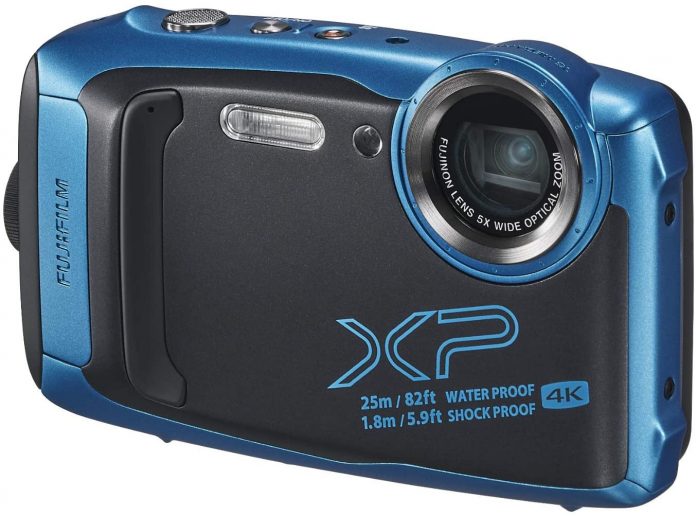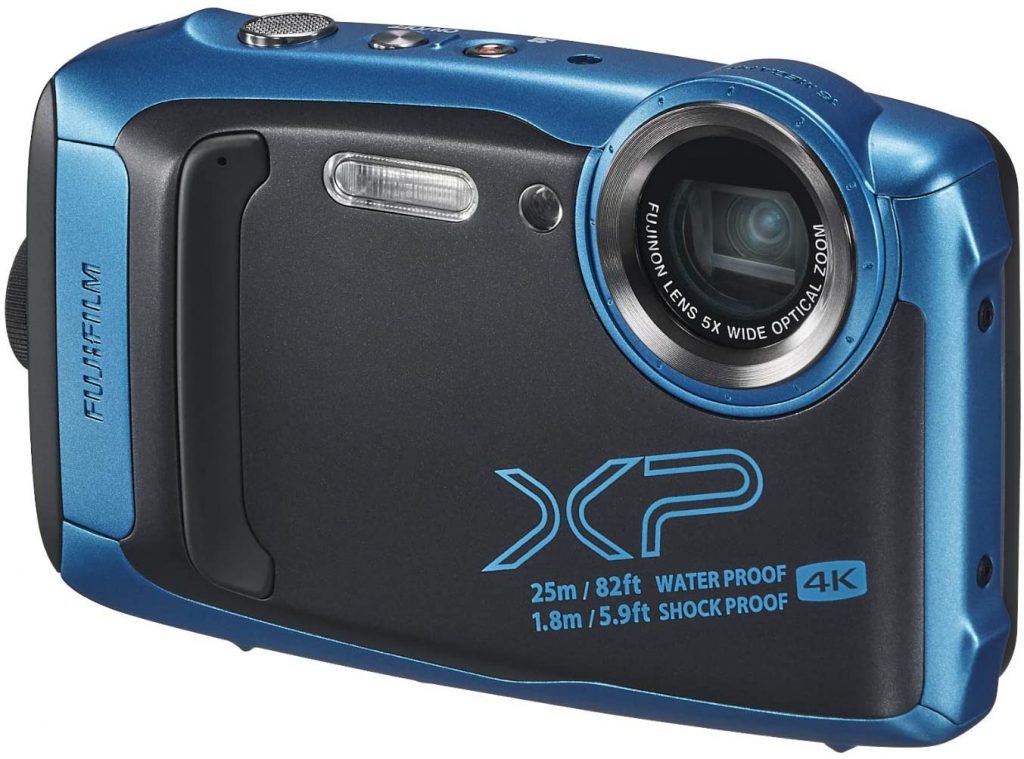After years of testing rugged cameras in rivers, on ski slopes, and in saltwater, I’ve learned that waterproof cameras occupy a unique niche. They’re not about pixel-perfect image quality – they’re about capturing memories in places where your $2,000 mirrorless would be destroyed in minutes. The Fujifilm FinePix XP140 understands this mission perfectly.
I’ve used the XP140 extensively over two snorkeling trips, countless pool days with kids, and a winter camping expedition. This review comes from real-world use, not just spec-sheet analysis. Let me tell you what this camera does well, where it falls short, and whether it deserves a spot in your adventure bag.
Contents
- What is the Fujifilm FinePix XP140?
- Specifications That Actually Matter
- Real-World Performance: The Honest Assessment
- Shooting Modes and Features
- WiFi and Smartphone Connectivity
- What the XP140 Does Better Than Smartphones
- What the XP140 Doesn’t Do Well
- Who Should Buy the Fujifilm FinePix XP140?
- Comparison to Alternatives
- Long-Term Ownership Considerations
- Tips for Getting the Most from Your XP140
- Frequently Asked Questions
- Is the Fujifilm XP140 good for snorkeling?
- Can the XP140 take good photos in low light?
- How does the XP140 compare to a waterproof phone case?
- Is 4K video on the XP140 worth using?
- How long does the battery last?
- Can you charge the XP140 via USB?
- Does the XP140 shoot RAW files?
- How durable is the XP140 really?
- Final Verdict: A Specialized Tool for Specific Needs
What is the Fujifilm FinePix XP140?
The FinePix XP140 is Fujifilm’s rugged compact camera, replacing the XP130 and XP120 models. It’s built for photographers who need reliability in hostile environments – underwater, in freezing cold, or covered in sand and dust.
This isn’t a camera for landscape photographers obsessing over corner sharpness. It’s for parents at water parks, snorkelers exploring reefs, skiers documenting runs, and travelers who want one camera that survives anything. The XP140 trades ultimate image quality for versatility and durability – and that’s exactly the right trade-off for this category.
Key Improvements Over Previous Models
The XP140 brings meaningful upgrades from the XP130:
- Deeper waterproofing: 25 meters (82 feet) versus 20 meters – enough for recreational diving
- 4K video: Finally added, though only at 15fps (more on this limitation later)
- Higher ISO range: Now up to ISO 12800 for low-light situations
- Bluetooth connectivity: In addition to WiFi for easier smartphone pairing
These aren’t revolutionary changes, but they address real user needs. The improved waterproofing matters if you’re diving with it. The 4K video, despite its limitations, future-proofs the camera somewhat.
Specifications That Actually Matter
Let me skip the meaningless marketing specs and focus on what affects real-world shooting:
Image Sensor & Resolution:
- 16.4 megapixel back-illuminated CMOS sensor (1/2.3″ size)
- Maximum image size: 4608 x 3456 pixels
- Good for prints up to 11″ x 16″ with acceptable quality
Lens:
- 5x optical zoom (28-140mm equivalent)
- Maximum aperture: f/3.9-4.9 (not particularly bright)
- Minimum focus distance: 9cm (adequate but not true macro)
- Internal zoom mechanism (no moving parts to compromise waterproofing)
Durability Ratings:
- Waterproof: IPX8 rated to 25m (82 feet) for up to 2 hours
- Shockproof: Survives drops from 1.8 meters (5.9 feet)
- Freezeproof: Operates down to -10°C (14°F)
- Dustproof: IP6X rated – completely sealed against dust
Video:
- 4K UHD at 15fps (too slow for most uses)
- Full HD 1080p at 60fps (this is what you’ll actually use)
- Digital image stabilization in 1080p 30fps mode only
Performance:
- Continuous shooting: 10 fps for 10 frames (burst mode)
- ISO range: 100-12,800
- Battery life: 240 shots per charge (modest – carry spares)
- 3-inch LCD screen (no viewfinder)
Connectivity:
- WiFi and Bluetooth
- Smartphone app for remote control and image transfer
- Geotagging via connected smartphone
Real-World Performance: The Honest Assessment
Image Quality: Good Enough, Not Great
Let’s be direct: the XP140 doesn’t produce stunning images. The small 1/2.3″ sensor and modest lens can’t compete with larger cameras. However, image quality is good enough for its intended purpose.
In ideal conditions (bright daylight, ISO 100-400), the XP140 produces sharp, colorful images suitable for social media, 4×6 prints, and digital viewing. Colors are vibrant – sometimes overly saturated, but this looks good for vacation photos. The automatic scene recognition works well, usually selecting appropriate settings without intervention.
Underwater performance surprised me positively. The dedicated underwater mode corrects the blue/green color cast effectively. Images aren’t National Geographic quality, but they’re far better than I expected for a $150 camera. The wide-angle end of the zoom works best underwater – telephoto shots lose detail quickly.
Low-light shooting reveals the camera’s limitations. ISO 400 is the practical limit for quality images. At ISO 800, noise becomes visible. At ISO 1600+, images are acceptable for phone screens but not printable. The maximum ISO 12800 is essentially unusable – muddy, noisy, and lacking detail.
The lens performs decently at wide-angle (28mm equivalent) but shows significant quality degradation at full telephoto (140mm). Images become noticeably softer, and chromatic aberration increases. For best results, stay below 3x zoom.
The 9cm minimum focus distance prevents true macro photography. You can get decently close for product-size objects, but don’t expect frame-filling shots of tiny seashells or insects.
Video Quality: Use 1080p, Skip 4K
The headline feature – 4K video – is essentially marketing fluff. At 15fps, 4K footage is choppy and unpleasant to watch. Any movement looks stuttery. I tried it once underwater and never used it again.
The real video star is 1080p at 60fps. This produces smooth, usable footage perfect for YouTube or family videos. The optical zoom works during recording, which is genuinely useful for following subjects. Image stabilization only functions in 1080p 30fps mode, so you’ll need steady hands at 60fps.
Audio is mono and mediocre – expect muffled sound underwater (obviously) and tinny audio on land. This isn’t a vlogging camera. The XP140 is for capturing visual memories, not producing polished video content.
The high-speed video modes (120fps, 240fps, 320fps) drop resolution dramatically. The 320fps mode records at just 160×120 pixels – essentially unusable. The 120fps VGA mode (640×480) is marginally useful for analyzing sports technique but looks terrible.
Durability: This Camera Takes a Beating
The XP140’s real strength is its toughness. I’ve dropped it on tile floors, submerged it repeatedly in chlorinated pools and saltwater, buried it in sand, used it in near-freezing temperatures, and it keeps working flawlessly.
The waterproofing is bombproof. The battery/card compartment features a double-locking mechanism that inspires confidence. I’ve never had a leak, even after hundreds of underwater sessions. The 25-meter depth rating provides substantial safety margin for snorkeling (typically 3-5 meters) and recreational diving.
After saltwater use, I rinse the camera under tap water and let it air dry. No corrosion, no problems. The durability alone justifies this camera’s existence – it goes places your phone and regular camera simply cannot.
One caution: The lens cover is plastic and shows scratches over time. These don’t affect image quality significantly, but consider a protective case if you’re throwing it into bags with keys and other hard objects.
Handling and Ergonomics
The XP140 feels solid and well-built. The rubber grips on front and rear provide secure handling, even with wet hands. The camera is genuinely pocketable – I routinely carry it in board shorts pockets at the beach.
The button layout is thoughtfully designed. The shutter button is raised and textured, making it easy to locate by feel – critical when your attention is on the shot, not the camera. The zoom toggle (W/T buttons) is thumb-accessible and responsive.
The 3-inch LCD screen is bright enough for outdoor viewing in most conditions, though direct sunlight can make it challenging. There’s no viewfinder, which would be nice for bright conditions but would compromise waterproofing.
The menu system is straightforward and logical. Most shooting can be done in automatic mode without touching menus. When you need specific settings, they’re organized sensibly and easy to find.
Battery life at 240 shots is modest. Heavy users will drain the battery in a day of active shooting. I always carry a spare battery and portable charger for multi-day trips. The NP-45S battery is compact and charges via micro-USB, which is convenient.
Shooting Modes and Features
Scene Recognition Mode: Your Default Setting
The automatic scene recognition mode analyzes subjects and selects appropriate settings. It works remarkably well – I leave the camera in this mode 90% of the time. The camera correctly identifies portraits, landscapes, underwater scenes, and other common situations.
Pre-Set Scene Modes
When automatic mode doesn’t nail it, dedicated scene modes help:
- Underwater & Underwater Macro: Essential for diving/snorkeling – corrects color cast and optimizes exposure
- Beach & Snow: Prevents underexposure in bright, reflective environments
- Action Camera Mode: Attempts to emulate action cam wide-angle perspective (doesn’t work as well as a real GoPro)
- Sunset, Night, Portrait, Landscape: Standard scene modes that work adequately
Creative Features
Panoramic shooting works up to 360 degrees. Sweep the camera across the scene, and it stitches frames together. Results are acceptable for social media but show visible seams under close inspection.
Cinemagraph mode creates video files where part of the image moves while the rest remains still. These are novelties – fun to experiment with once, then forgotten.
Time-lapse movie mode captures stills at set intervals (3 seconds to 10 minutes) and combines them into video at 10, 30, or 60fps. Genuinely useful for sunsets, cloud movements, or documenting projects.
Burst Shooting
The camera shoots 10 fps for up to 10 frames at full resolution – adequate for capturing decisive moments with kids or wildlife. An ultra-fast 60 fps mode exists but drops resolution dramatically, making images less useful.
WiFi and Smartphone Connectivity
The Fujifilm Camera Remote app (iOS/Android) connects via WiFi or Bluetooth for image transfer and remote control.
Image transfer works efficiently. Select photos on the camera’s screen, and they download to your phone within seconds. This makes sharing vacation photos immediately to social media practical.
Remote control functionality is limited but functional. You can see live view on your phone screen and release the shutter remotely – perfect for group shots where you want to be in frame. However, you can’t adjust exposure compensation, use burst mode, or activate the self-timer remotely.
Geotagging requires a connected smartphone. The camera itself lacks GPS, but it pulls location data from your phone and embeds it in photos. This works seamlessly if you remember to connect before shooting.
The app interface is basic but gets the job done. Don’t expect advanced editing or elaborate features – it’s purely functional.
What the XP140 Does Better Than Smartphones
This question matters more than any specification. Why buy a dedicated waterproof camera when phones are waterproof now?
1. True waterproofing: Phones are splash-resistant, not dive-rated. The XP140 can go 25 meters deep for extended periods. Phone manufacturers specifically warn against saltwater exposure. The XP140 thrives in it.
2. Optical zoom: The 5x optical zoom maintains image quality. Phone digital zoom degrades images quickly. Underwater, zoom capability matters when you can’t easily move closer to subjects.
3. Physical controls: Buttons work with wet fingers and gloves. Touchscreens don’t. Underwater, physical buttons are essential.
4. Dedicated purpose: This camera is designed for harsh environments. If it gets dropped, scratched, or lost, you’re out $150, not $1,000. The psychological freedom to use it carelessly is valuable.
5. Battery life: Using your phone as camera drains its battery. With the XP140, your phone remains available for communication and navigation.
What the XP140 Doesn’t Do Well
Honesty requires acknowledging limitations:
Image quality is mediocre. If print quality matters or you shoot in challenging light, this camera will disappoint. The small sensor and modest lens can’t match larger cameras or even high-end smartphones in ideal conditions.
4K video is useless at 15fps. This “feature” exists purely for marketing and should be ignored.
No manual controls or RAW shooting. Enthusiast photographers wanting creative control will find the XP140 frustrating. This is a point-and-shoot camera in the truest sense.
The lens isn’t particularly bright (f/3.9-4.9), limiting low-light capability. Underwater, where light dims rapidly, this becomes noticeable.
Macro capabilities are limited. The 9cm minimum focus distance prevents extreme close-ups.
Battery life is modest. Active shooters will need spare batteries for full-day outings.
Who Should Buy the Fujifilm FinePix XP140?
Perfect for:
- Families with young children: Pool days, beach trips, water parks – this camera survives kid chaos
- Snorkelers and recreational divers: Captures underwater memories without expensive housing
- Travelers wanting worry-free photography: Toss it in your bag without concern
- Outdoor enthusiasts: Hikers, campers, skiers needing rugged reliability
- Casual photographers prioritizing durability over quality: Good enough images, unbeatable toughness
Skip it if you’re:
- Seeking excellent image quality – get a regular camera and protective housing
- Wanting manual controls or RAW files – this camera doesn’t offer them
- Prioritizing 4K video – the 15fps limitation makes it unusable
- Shooting primarily in low light – the small sensor and slow lens struggle
- Already satisfied with your waterproof phone – you might not need this
Comparison to Alternatives
The rugged camera market has shrunk dramatically as smartphones improved. The XP140’s main competition comes from:
Olympus Tough TG-6: Superior image quality, brighter f/2.0 lens, better macro capability, microscope mode. More expensive ($400+) but noticeably better overall.
Nikon Coolpix W300: Similar specs, adds GPS and compass, slightly better build quality. If still available, worth comparing prices.
GoPro Action Cameras: Different category – ultra-wide perspective, better video, worse photos. Choose based on whether you prioritize stills (XP140) or video (GoPro).
Smartphone in Waterproof Case: Better image quality in good light, but limited depth rating, no zoom, touchscreen issues underwater. Works for casual pool use; inadequate for serious underwater photography.
The XP140 occupies the budget rugged camera niche. It’s not the best image quality or the toughest, but it balances capability and affordability effectively.
Long-Term Ownership Considerations
Durability proven: Users report these cameras lasting years with proper care. Rinse after saltwater use, avoid leaving in direct sun for extended periods, and it should serve reliably.
Spare batteries recommended: The NP-45S battery is affordable ($15-25). Buy one or two spares and a charger for extended trips.
Memory card capacity: The camera accepts SD/SDHC/SDXC cards. A 32GB card holds roughly 4,000 JPEGs or 30 minutes of 1080p 60fps video – adequate for most users.
Firmware updates: Fujifilm occasionally releases updates. Check their website after purchase for any available improvements.
Service and support: Fujifilm’s reputation for service is solid. Register your camera for warranty coverage.
Tips for Getting the Most from Your XP140
After extensive use, here’s what I’ve learned:
1. Stay at wide-angle underwater: Image quality degrades significantly beyond 2-3x zoom. Get physically closer when possible.
2. Use underwater mode religiously: It makes a dramatic difference in color accuracy.
3. Shoot at ISO 400 maximum when possible: Higher ISOs sacrifice too much quality.
4. Record video at 1080p 60fps: Ignore the 4K mode entirely.
5. Carry spare batteries: The 240-shot rating disappears quickly with heavy use.
6. Enable image stabilization for video: Use 1080p 30fps mode for steadier footage.
7. Rinse after saltwater use: Fresh water rinse prevents corrosion and extends camera life.
8. Use the wrist strap: Prevents expensive drops, especially underwater.
9. Let automatic mode do its job: The scene recognition works well – don’t overthink settings.
10. Set realistic expectations: This camera captures moments, not masterpieces.
Frequently Asked Questions
Is the Fujifilm XP140 good for snorkeling?
Yes, absolutely. The 25-meter depth rating provides enormous safety margin for snorkeling (typically 3-5 meters deep). The underwater mode corrects color cast effectively, and the camera handles easily with wet hands. I’ve used it extensively for snorkeling with excellent results. Just remember to use the wrist strap – dropping it in open water means it’s gone forever.
Can the XP140 take good photos in low light?
No. The small sensor, slow lens (f/3.9-4.9), and limited ISO performance make low-light photography a weakness. ISO 400 is the practical limit for quality images. Beyond that, noise becomes problematic. For well-lit situations, the camera performs fine. For dim environments, look elsewhere.
How does the XP140 compare to a waterproof phone case?
The XP140 offers deeper waterproofing (25m vs typically 3m for phone cases), optical zoom, physical buttons that work underwater, and dedicated battery so your phone remains available. Phones have better image quality in good light. For casual pool use, a waterproof case works. For serious underwater photography or harsh environments, the dedicated camera is superior.
Is 4K video on the XP140 worth using?
No. The 15fps frame rate makes 4K video choppy and unpleasant to watch. Always shoot 1080p at 60fps for smooth, usable video. The 4K spec is marketing – ignore it entirely.
How long does the battery last?
The official rating is 240 shots per charge. In real-world use, expect 150-200 shots with moderate LCD review and WiFi use. Heavy video recording or extensive playback drains the battery faster. Always carry at least one spare battery for full-day shooting.
Can you charge the XP140 via USB?
The camera includes a micro-USB port for charging, though it’s inside the sealed battery compartment. You can charge the battery in-camera or purchase a separate wall charger for faster charging.
Does the XP140 shoot RAW files?
No. The camera only records JPEG files. There are no manual exposure controls or RAW capability. This is a fully automatic, point-and-shoot camera.
How durable is the XP140 really?
Very durable in my experience. I’ve dropped it multiple times on hard surfaces, submerged it hundreds of times, used it in sand and dust, and it continues working flawlessly. The build quality inspires confidence. Rinse it after saltwater use, and it should last years.
Final Verdict: A Specialized Tool for Specific Needs
The Fujifilm FinePix XP140 isn’t trying to be the best camera – it’s trying to be the most reliable camera in hostile environments. By that measure, it succeeds admirably.
Image quality is adequate, not exceptional. Video capability is acceptable (in 1080p – forget 4K). Features are basic, not advanced. But durability is outstanding, usability is excellent, and price is reasonable.
This camera exists for situations where no other camera can go. Beach vacations where sand and spray ruin electronics. Snorkeling trips where you want memories of coral reefs. Winter sports where freezing temperatures kill phone batteries. Pool parties with kids where expensive gear faces certain destruction.
In these contexts – and only in these contexts – the XP140 excels.
If you need a camera that simply works anywhere, without worry or fuss, the Fujifilm FinePix XP140 deserves serious consideration. Just understand what you’re buying: a specialized tool for specific situations, not an everyday camera for general photography.
For casual outdoor photographers, families, snorkelers, and adventurers prioritizing reliability over perfection, the XP140 hits the sweet spot of capability and value. It’s not perfect, but it’s tough, affordable, and goes anywhere.
And sometimes, that’s exactly what matters most.
Last update on 2025-12-25 / Affiliate links / Images from Amazon Product Advertising API





